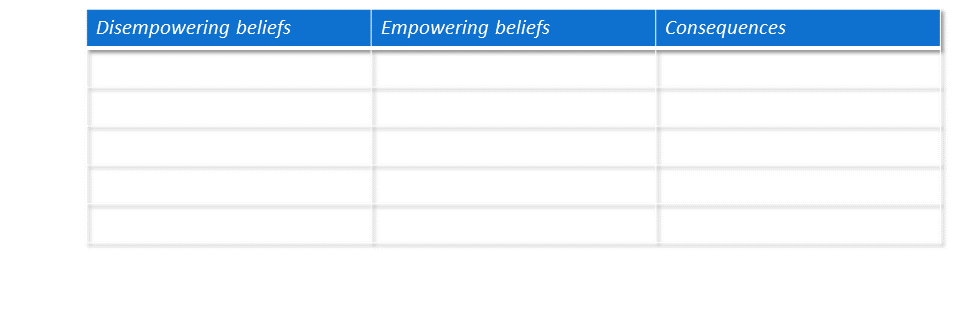To get yourself in the right frame of mind for this exercise, take some time to reflect on any beliefs you have about yourself and your situation - or your team and its situation - that might be holding you back from reaching your full potential. You are going to work on these beliefs that are holding you back, and try to overcome them.
As you think about any beliefs you have that might be holding you back, jot them down on a piece of paper. You can spend 10 minutes to brainstorm them if you are doing this exercise in a team setting. (Even in a team setting it's always best to give people some time on their own to jot down thoughts before you collect together all team members' ideas - see the page on effective brainstorming techniques).
This exercise is about any beliefs you hold that are unhelpful or disempowering, however true or not the beliefs are in reality. Sometimes they have a grain of truth in them, but you have got them out of proportion; sometimes they are beliefs that others would be very surprised to know that you have about yourself or your team. They even be true in reality, but still very unhelpful - for example that you get nervous before making a presentation. These beliefs are known as 'disempowering beliefs'.
You can also include here general patterns of thinking that you know you easily fall into but aren't helpful - eg always focusing instantly on the worst thing that could happen. Psychologists call these 'cognitive distortions'. (The link takes you to an exercise specially devoted to dealing with these, with descriptions of ten common cognitive distortions, because they can cause us particular stress).
When you have an idea of what your particular disempowering beliefs are:
- Draw lines to divide a page into three columns. Head the left-hand column ‘Disempowering beliefs’, the middle column ‘Empowering beliefs’, and the right-hand column “Consequences’

- Now write your 'disempowering beliefs', one underneath the other, in the left-hand column.
- When you have done that, look back at your first ‘disempowering belief’ and write a ‘freeing assumption’ or ‘empowering belief’ about the exact same topic in the middle column. What is the corresponding 'empowered belief'?
- Now spend some moments reflecting on what it would be like to replace your ‘disempowering belief’ with the empowered version? What would you do differently? What would the consequences be? Note consequences in the right-hand column.
- An example of a disempowering belief for an individual might be: "I feel bullied by my boss, but there is nothing I can do about it" and the corresponding empowering belief might be " I can do something about it". The consequence of this change in belief might be that you decide to approach HR, or a trusted colleague, confidentially about the bullying.
- An example for a team might be: "We don't have the resources to do everything we are asked to do so we constantly feel we are performing badly", and the corresponding empowering belief might be "Our resources are fixed so we should make some decisions on what is most important and stop blaming ourselves for not addressing the less important tasks". The consequence may be that you communicate to your stakeholders and customers that you have to prioritize, why you have to do this, and that your focus will be on your top three priorities.
- Go through your ‘disempowering beliefs’ one by one in a similar fashion.
- Finally, pick just one disempowering belief that you will consciously look out for over the next week. As an individual, when you find yourself thinking it, immediately replace it in your mind with your empowered version and act according to the empowered belief. As a team you can help each other: if you spot a conversation in the team that is going back over your disempowered beliefs you can flag it up and try as a team to move onto more positive ground.
Over time, replacing your 'disempowering beliefs' with more positive beliefs about yourself and your surroundings will increase your resilience and happiness.
